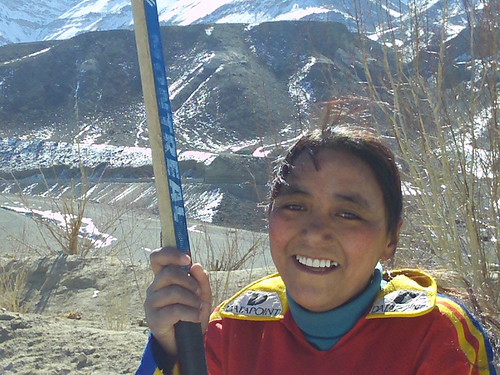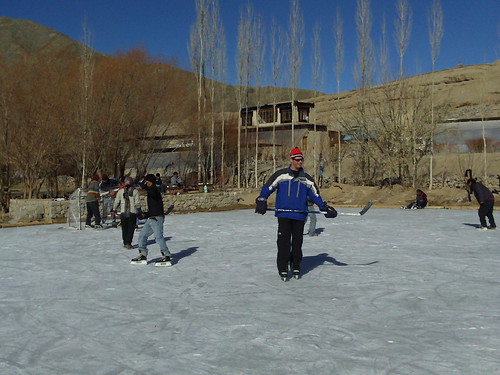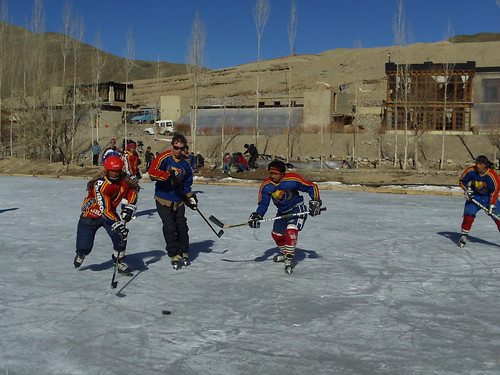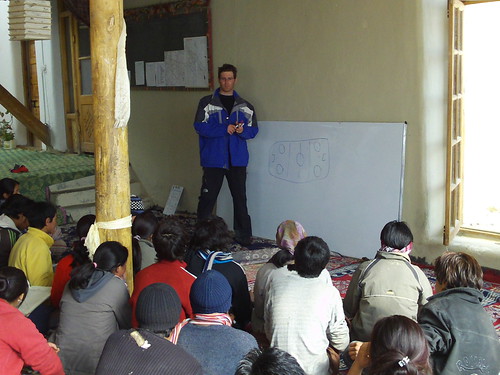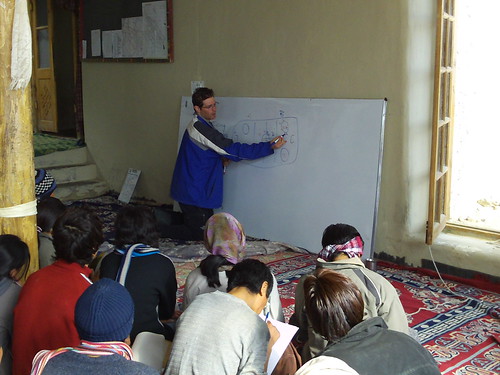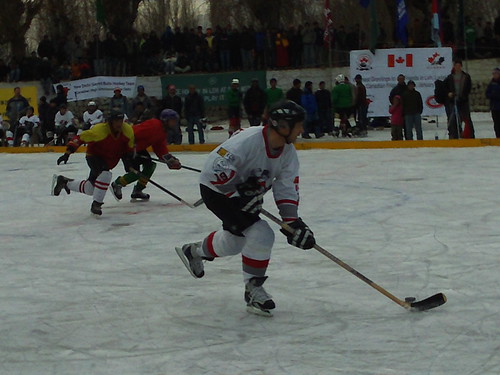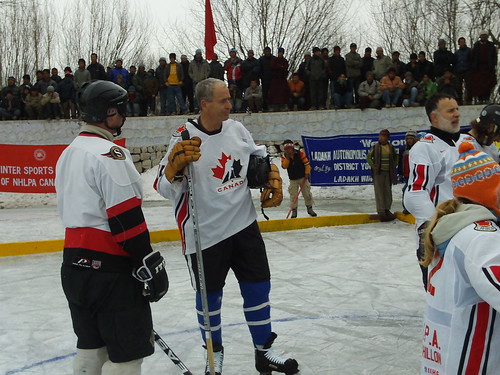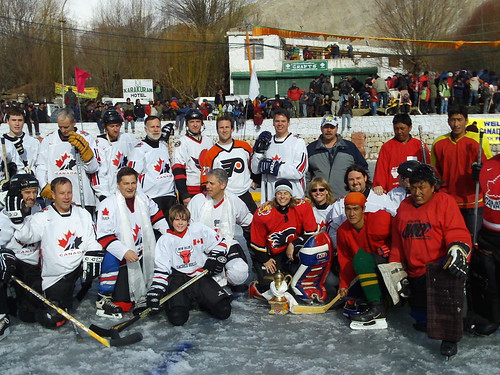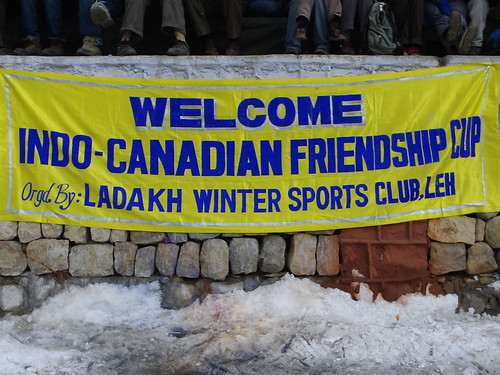I spent a lot of time thinking about this, and I know you will recognize the immense amount of thought that went into this philosophical analogy:
Ladakh is like a Manhattan cocktail…the tall, dark, attractive alcoholic beverage.
Think about it, the ingredients for a Manhattan (traditionally) are:
• Rye
• Sweet red vermouth
• Dash Angostura bitters
• Maraschino cherry (Garnish)
When I look at these ingredients, my first instinct is to back away slowly. Rye is not the friendliest of whiskeys, with a more peppery and dry taste, and vermouth is the equivalent of drinking vomit, in my humble opinion. If that isn’t nauseating enough, add in some bitters for good measure. And just when you thought you had the drink figured out, it goes and surprises you with a cherry on top. Somehow it comes out tasting refined, distinguished, and well put together.
The comparison to Ladakh is like this:
[taking a deep breath]
You arrive in Ladakh with grandeur, as you well know, weaving in and out of the mountains. You step out into a tiny airport, with minimal amenities, but you ignore them. You then get harassed by a handful of taxi drivers shouting in Ladakhi, but you’re OK with that, because they’re taxi drivers. You arrive in Leh, and it’s dirty. Garbage is everywhere, which usually includes raw sewage. You don’t mind the people walking everywhere in the streets like a bunch of headless chickens, but are more concerned about the wounded canines, the fattened bovines, and the subtle asses (the donkeys). The people show you one face in public, and another in private, souring your impression of them. Nonetheless, they’re friendly and hospitable, and marked with an interesting history and culture, that in many ways appears timeless, or rather static.
When you analyze any of these ingredients that make up Ladakh, you find that the cocktail is made with ingredients that don’t seem too appealing, yet when all combined, they make up something unique, and even addictive.
Ladakh has a way of overtaking you. It has obvious drawbacks, like the lack of running, hot water, heated/insulated buildings or western toilets, among the other mentioned characteristics, yet somehow that’s what you love about it. That’s the addiction. Rarely would you consume the individual ingredients of a Manhattan, but when they’re shaken (not stirred) together, you learn to not only appreciate and enjoy it fully, but you learn to love every component.
For your information, I’ve never consumed Manhattan before, but all this talk of one has made me interested.
As a secondary note, not to get too side-tracked, ‘s apparently an episode of Sex in the City that mentions the cocktail. Episode 90, last scene. I’ve never seen it. I swear.
We now return to our regularly scheduled hockey blog…
Not even a week after leaving Ladakh, I was back on a plane heading to Leh. This time, my mission was even more focused: train the Indian ice hockey team and prepare them for the 2009 IIHF Challenge Cup of Asia in Abu Dhabi, the capital of the United Arab Emirates.
It was a bit surreal, stepping off the plane after that incredible descent, retracing all of my steps. The first time around, I was lost, confused, and naive. Now I was entirely prepared, comfortable, and a hell of a lot more knowledgable about Ladakhi culture (although by no means an expert). Getting through the airport was quick, although my luggage wasn’t, and I was able to instruct my taxi driver where to take me, although the price was not to my liking. This time around, though, I wasn’t staying at SECMOL. The experience was very unique there, but since it was a major diversion in the opposite direction of Leh. My training would be focused strictly in the immediate area around Leh, and if I had my way, at the rink within the town.
That was my first point of business. After I dropped off my bags at the guest house I had previously stayed (where Tashi Angchok lives), I walked the 2km back into the center of town and to the office of the Ladakh Winter Sports Club. With obvious awareness to the difference in situations, importance, and ego, I felt a bit like General MacArthur upon his return to the Philippines during WWII. I wanted to come to the rescue of hockey in Ladakh - and India as an extension - and I felt like a hero just by returning. But like all ego trips, that only lasted for about a day.
The following day, practice began at Karzu/Karzoo (you choose) ice rink, located somewhat in the center of Leh, if you could geographically figure such a thing out in a town with chaotic roads and scattered hills. The rink is on a pond that is submerged in comparison to the road that encircles it, with stone walls about 6-7 feet high surrounding the full rink. In a few spots, there are some major hazards, in particular, the stairway when entering the rink, which would be partially submerged under thin ice (I punched through at the bottom and had a freezing foot), and the corner of the rink where the running water would enter the pond. This constant stream of water collected and made it nearly impossible for that section of the pond to freeze, which then broke down the stability of the entire rink at time.
We agreed to start practice at approximately 8:00 am so that the ice would be as firm as possible, and we could get off in time for the children’s clinic that was being run by my friend and resident of Ladakh, Henk, which began at 10:00 am.
Henk held this clinic for 15 days, donating his own time as a volunteer coach, teaching children between the ages of 5 and 15 (approximately). It was an extraordinary sight to see, all of these kids on the ice, day in, day out, and I’m positive his instruction was invaluable to everyone on the ice! I look forward to coaching some of these kids as well, as the Indian ice hockey program develops.
In terms of the India ice hockey team, we began day one a little late, with one of the military groups being delayed through no fault of their own. My policy for team practices was that any time players were late, they had to do “suicides”, which would reinforce their determination to arrive on time, something that’s not as common in Ladakhi (or Indian) culture.
For your reference, “suicide” is a skating drill that is fantastically exhausting. You start on the goal line, at one of the ends of the rink, and proceed to skate to the nearest blue line. Then stop, and skate back to the goal line and stop. You’re not done. Now do this to the red line, in the center of the rink, then back to the goal line. Tired yet? Too bad. Skate to the far blue line and back this time. Do you need some water? You can’t have any. Not until you proceed to skate to the opposite goal line, at the far end of the rink, and return to where you started. Ok, feel free to get some air now. Only problem is that you’re skating at an altitude of nearly 12,000 feet (3,300 meters), and the oxygen in the air is scarce.
When you live at low altitudes, you can’t comprehend what that means, but I can assure you that when your lungs are gasping for every last bit of available air, you learn very quickly the seriousness and intensity of high altitude training.
The clincher to the “suicide” drill is that there was an additional caveat to what happened when I made them do the drill: I had to do it too.
I always hated the drill when I training as a teeneger. I think the term came about because half way through the drill, you start to consider suicide as a better option than skating. At some point, the brilliant idea came to me that I should punish myself when I punish them, being that I’m responsible for the team as their coach. Since Indians and Ladakhis have a (slightly) greater level of respect and reverance for the person in charge, especially since half of my team is from the military, I figured I would add extra motivation to prevent them from screwing up if they saw me suffer as well. Let me assure you, I suffered.
Even though I agreed that the players had a good reason for being late that first day, I still made them skate, and kept my word by skating with them. I thought I was going to die.
Five minutes later, when blood finally returned to my brain, we began with some of the basic drills that we had done prior to my first departure from Ladakh. They had not really improved.
Happy Adam quickly stepped aside, and made way for frustrated Adam. (I’ll use 3rd person sparingly). After my first day working with the team the first time around, a group of player told me, “we’re not basic”. I placated them at the time and told them, “I o, but we need to start from scratch”. Unfortunately, in regards to hockey skills and understanding, they were and are basic. I hoped that with the foundation I was providing, that they’d have improved at least mildly to this point in time, and have a greater understanding of the game, but I was proven wrong.
The team couldn’t do the basics that we had worked on initially, 2-on-0, 2-on-1, etc. They were still unable to skate strong, pass accurately, or shoot to a spot on the net of their choosing, that is, if they were able to hit the net. For ten days, I watched them miss the net from 10 feet away. For ten days, they lined up improperly for faceoffs. For ten days, players would collide into each other in a drill that explicitly explained who went in front, who went behind. For ten days, shots would go out of the rink, and nobody bothered to get them (we only had 6-8 pucks to practice with!). For ten days, players shot at the net when the goalie wasn’t looking, often hitting him in a tender spot. For ten days, players would screw up simple tasks for 45 minutes, even after it was explained to them in English and Ladakhi…TEN times! For ten days, I ended up yelling way more than I am comfortable doing.
That’s not to say we didn’t have fun and didn’t improve, but I was dealing with a team that was not contributing the attention, effort and brain-power required to be a successful hockey team. I wasn’t seeing the determination and character that a national hockey team should have. At the same time, what could I expect? These guys were in a tough position. For years, they had been playing a style of hockey unique to their corner of the world. They didn’t know anything otherwise. Then the best players got selected to represent their country in an international competition. How would you feel? Proud, maybe even cocky? How about equally scared and insecure? Add in an international coach that is more talented than you (there’s no other way to put it) and is obviously not happy with your progress, and you can include embarassment and shame to the list.
I tried to counter-act that with on-ice games, like skating, passing and shooting competitions (the losers did suicides, including myself…again), and humility on my part. The only reason I went back to Ladakh was to help them get better. They are the team. They are the ones representing their region and their country. I’m not even getting paid! My disappointement was an expression of what I felt they owed to each other and those they were playing for.
I wanted to borrowed Miracle from SECMOL so that I could not only familiarize the team with the incredible and inspiring story of the 1980 US Olympic team, but also show them the potential parallels if we could band together and prove everyone wrong. Also, this was the first opportunity for them to watch people play hockey. Even though it’s a movie, it’s possibly the best hockey movie in regards to the hcoeky skills on display (if not the best hockey movie overall…don’t attack me for that!).
Speaking of SECMOL…whatever my frustration at the level of performance out of the team during the week and a half of practice, multiply that by another ten when it came to SECMOL. If you can recall from the first time around, the SECMOL players were passive in how they approached attending the 3-day clinic, and although it wasn’t entirely their fault at that time, they showed early signs of not having the mental toughness and passion required to represent their country. This time around, things were no different.
My announced return came only 2-3 days before I arrived. I won’t say that’s an eternity, but it’s certainly enough time for word to spread. I am confident that the Ladakh Winter Sports Club DID NOT reach out to the SECMOL players, and they kept up their rhetoric regarding the SECMOL players not reaching out to them. Other than that, how would they know I was coming back? I give them a pass on that one, but not to the LWSC. After day one of practice, there were some announcements on the local news regarding the team. At that point, SECMOL was assured practice was on, and I received a call that night. In my chat, I instructed the two players to be ready for the army bus at 7:00 am, to ensure they would all arrive on time, and was guaranteed that would be the case. The next morning, no SECMOL players.
Obviously, I was annoyed. These guys were hurting the chemistry of the team by not being there, and insulted the work that was being put into developing the program. I received a call 3/4 of the way through practice, in the middle of running a drill, notifying me that one player didn’t come because he couldn’t get out of work…at SECMOL. He was responsible for teaching a class that day on campus, and didn’t have enough time (from the previous evening) to reschedule it. If he really wanted to, he could have…I’m positive of that. In response to his last minute decision not to go, the other player decided he wasn’t going either, as he would have to walk 3km (1.5 miles) to the road, at dawn, and await the arrival of the army bus. Since nobody communicated any of this to myself or the army players, they were left waiting for 20 minutes for players that never showed.
I called SECMOL a few hours later, and discussed the importance of showing up, to which the response was that since the players couldn’t afford to pay to participate, they didn’t have the motivation to play. I can understand the frustraion of having to pay to play for a tournament of this nature, but unfortunately the India hockey program is at its infancy, and there are no funds available. I explained that the players should still show up to show their support, but to also improve their own hockey skills. I also enquired into whether SECMOL could pay for the players to participate, as it seemed like a great way to give their students a chance to really move up in the world (I perceive a school as trying to help its students any way possible, but maybe that’s my idealism coming out once again), as well as great recognition for SECMOL itself (they could put it on their website, touting that two SECMOL students are on the national team, and use that to solicit more donations, support and volunteer), and was quickly met with a curt, “we don’t have any money!” I decided it was time to go to SECMOL and present my case.
I returned to SECMOL that evening with Tashi and his new group of fifteen VIS students, replacing the half-dozen or so that had been there a few weeks prior. I felt like the resident Ladakhi expert when I met these (mostly) high school kids. Earlier that day I had shared with them some of the good and bad of Ladakh, but knew that most of it wouldn’t set in until a month or so into their stay. Fortunately, their trip started as Winter was winding down, and as the season changes, Leh opens up to the outside world. I was there for the Winter, and we already discussed those hardships.
When I arrived at SECMOL, I had a few points of business to take care of. Firstly, I needed to speak to the players to explain why their presence is so important. Secondly, I wanted to speak to one of the folks in charge, to explain why I felt SECMOL should support them. Third(ly?), I wanted to grab a few hockey movies that they had in their posession (like Miracle) so that I could show it to the team, and lastly, I wanted to get my skates sharpened by one of the departing VIS students that sharpens skates when he’s in Vermont. All of those were accomplished.
As expected, the players showed up the next day with the army, and for a week or so, practices progressed, if at a tortoise’s pace. I tried my hardest to improve the basics, while implementing the most beginner of strategy. Off the ice, we discussed the concepts and reasoning behind how you position yourself on the ice, and how to work together as a team. I showed them Miracle, which they were absolutely loving, but we had to stop the movie in the middle because the DVD player started to smoke…really. Two days we concluded the movie, and the guys were on the edge of their seats as USA defeated USSR and Finland.
I spoke with them at length regarding my frustraion with their lack of focus and mental discpline, and went into a SWOT (Strengths, Weaknesses, Opportunities, Threats) Analysis. Needless to say, Strengths were not our prominent category, but we found a few, and agree to magnify those aspects of our game, and obviously improve the contrary.
I also drafted up a document entitled, “So you want to be a hockey player…”, reviewing and outlining all of the things that only partially lay out the things one would have to do to support their hockey career, such as cutting out certain foods, alcohol and tobacco, doing relevant exercises (like yoga), and carrying themselves in a manner that honors the traditions of the game.
It was relative smooth sailing, although frustrating nonetheless, until we started to run into a few unfortunate events. Among the most significant was the weather. Every evening, the temperature would make it down below the freezing point, but during the day, it would rise a few degrees over. We kept our practices early to combat this, but the problem intensifies with time. At high altitude, the sun is much closer and stronger, and when the ice melts a little on day one, it accumulates a little bit every day (when the weather is consistent). This was the pattern for almost the entire duration, with the ice becoming worse every day.
Because of the weather conditions, the playing surface of the rink suffered. In many damaged areas, I used cones to detour to the team so that they wouldn’t fall in. There were holes in some spots as well, which I surrounded with cones, although that didn’t stop a handful of pucks from going into the pond through those tiny holes. At one point, when 2 players collided on the drill that should be collission-less, they both fell, lost the puck, and it went scurrying into one of the holes on the surface, like it had an instinctive desire to go swimming. I was more pissed about the puck than I was about the players colliding stupidly.
When the team stood in one spot, the ice would begin to crack, sounding like a whip. The prospect of falling into the cold, dirty pond, in chest high water (I assume), was not on the top of my to do list. If for anything, I was more freightened about the garbage than I was about getting out of the water or catching hypothermia.
It drama came to a climax near the end of my stay in Ladakh, when we were doing a skating/passing drill (something we still hadn’t perfected). One of the SECMOL players fell, and was in obvious pain. I skated over to him, and his mouth was open and he was writhing on the ice like a snake. I knew immediately, this was a seizure. Players came over and held is body, stabilizing his head and taking off his skates. Some massaged his feet (to this day, I’m not really sure why, although I assume it was increase blood flow). His eyes went into the back of his head, and he was foaming from the mouth, until he lost consciousness.
As the team stood around, the ice began to crack, to which I shouted to clear the area, and call a doctor. Nobody did anything. I repeated my request/command, and just now do I recall that I may have told people to “call 911!”, which would explain their lack of response, since 911 is not the emergency line in India. Eventually, a player pulled his car near the rink, and a group of players picked up their teammate and hoisted him over there head, 7 feet high, to get him over the wall surrounding the rink and into the car, and to the hospital.
An hour or so later later, we got confirmation that it was indeed a seizure, but that he was ok, albeit dazed and confused. Initially, my assumption was that he had caught a rut in the ice, fallen, hit his head, and gone into a seizure. What actually happened was that he went into a seizure while skating and fell, but didn’t hit his head (or hit it lightly). They were keeping him for 72 hours for observation and more tests.
Because of this happening, and my concern for safety (a foreign concept in India - and China for that matter, but you’ll have to request those stories from me another time), I ended practice early, and instructed the players to remove the nets (which were usually left on the rink 24/7), and shut down the rink for the day (if not for the season). I spoke to Henk, and suggested that they cancel their youth clinic for the day, and he agreed. Apparently, the LWSC didn’t.
I voiced my concerns (forcefully at times, sarcastically at others) that it’s not worth risking a serious injury for one of the kids, and was met with disregard. The parents had paid, so the feeling was that the kids should skate. I suggested that they return the money for one day. Even if all went well, it’s not worth taking a chance, because if tragedy does strike, it would be catastrophic.
This became a pattern.
TO BE CONTINUED…





